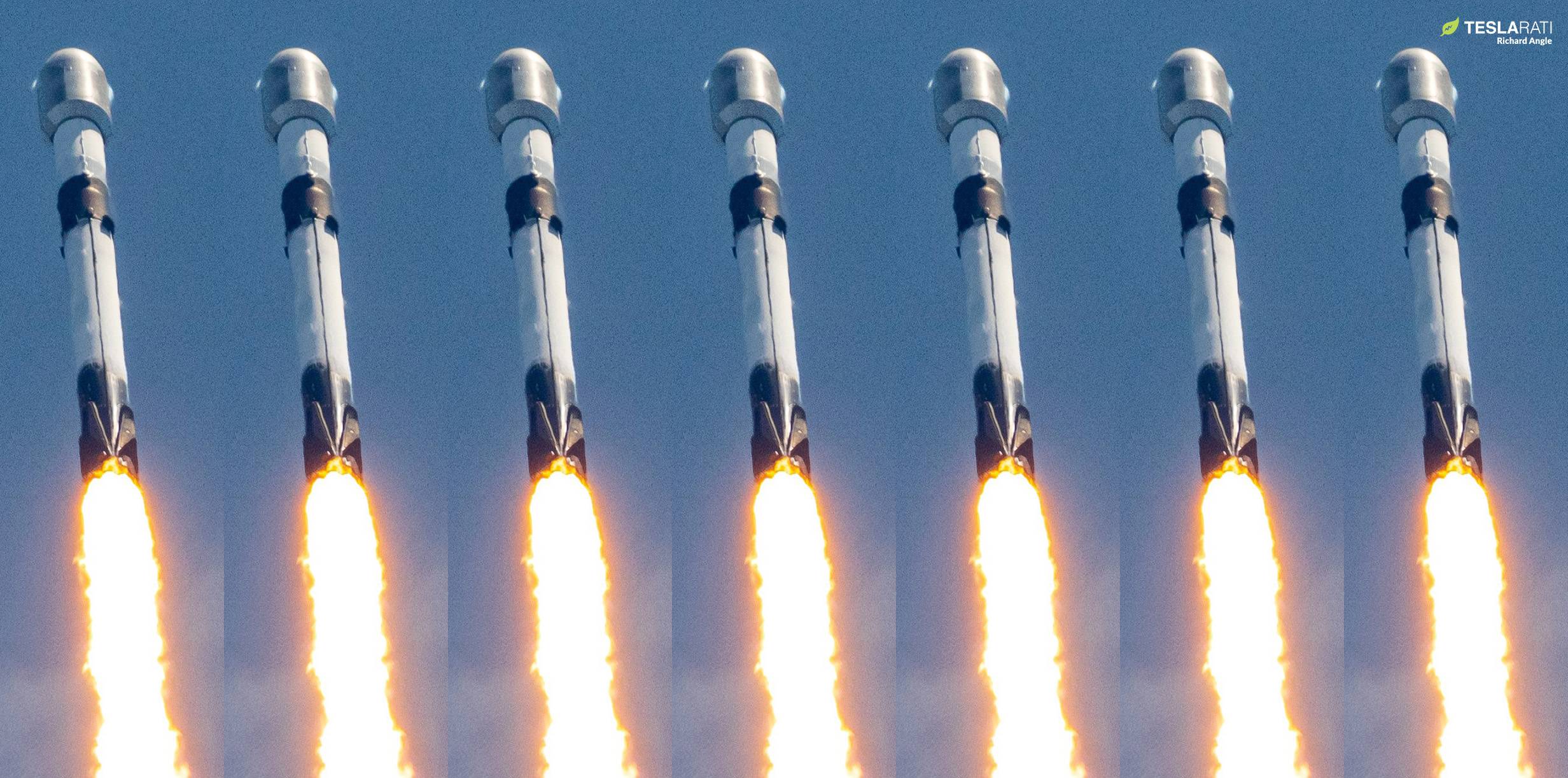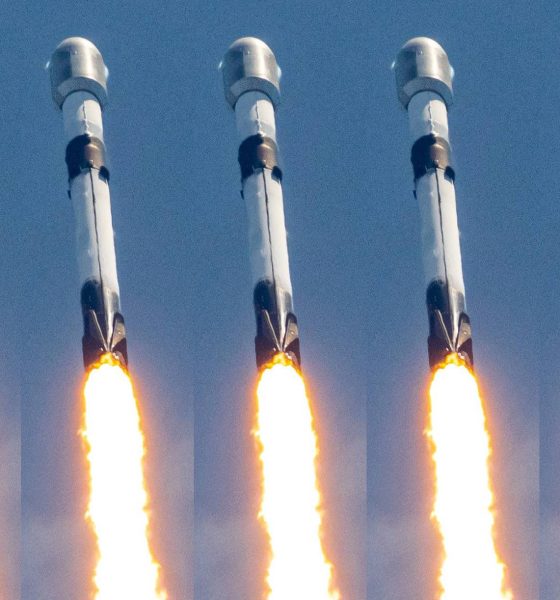SpaceX is less than a month into 2023, but CEO Elon Musk’s wildly ambitious goal of 100 launches in one year is already looking doable.
Announced last August, Musk’s 100-launch 2023 target followed goals of 52 – and then 60 – Falcon rocket launches in 2022. Both 2022 goals were incredibly ambitious, with 60 requiring SpaceX to almost double its previous annual launch record. But for the first time in its history, SpaceX not only met – but exceeded – its executives’ forecasts. The company launched 61 times in 2022, tying a four-decade-old Soviet record for the most launches of a single family of rockets in one year. Anywhere close to 100 Falcon launches in 2023 would crush that record.
Prior to 2022, however, SpaceX infamously struggled to hit the high bars set by its ever-optimistic executives.

The update that's rolling out to the fleet makes full use of the front and rear steering travel to minimize turning circle. In this case a reduction of 1.6 feet just over the air— Wes (@wmorrill3) April 16, 2024
High achievements; higher bars
In September 2017, Musk predicted [PDF] that SpaceX would launch 20 times in 2017 and 30 times in 2018. SpaceX eventually launched 18 times in 2017 and 21 times in 2018. In September 2019, COO Gwynne Shotwell predicted that SpaceX would launch up to 18 times by the end of the year. The company would only launch 13 Falcon rockets in 2019 – the only time in the last 12 years that SpaceX’s launch cadence has dropped year-over-year.
At the same conference, Shotwell – typically viewed as the adult in the room relative to Musk’s more chaotic management style – also estimated that SpaceX would launch up to 24 Starlink missions in 2020. SpaceX went on to launch 26 times total in 2020, 15 of which were for Starlink. Finally, in October 2020, CEO Elon Musk revealed a target of 48 SpaceX launches in 2021. Instead, SpaceX launched 31 Falcon rockets – an impressive accomplishment by any measure but still far from its internal target.
Only in 2022 did all of the puzzle pieces finally click together. Representing the payoff from years of buildup, SpaceX doubled the production of Falcon rocket stages and Starlink satellites, dramatically increased the availability of its drone ships and launch pads, and launched once every six days without a single failure.
(6)0 to 100
Ever the glutton for self-punishment, Musk responded to SpaceX’s success by raising 2023’s bar two-thirds higher than 2022’s in August. Instead of jinxing the company, SpaceX somehow sustained its high cadence through the end of the year and slightly surpassed Musk’s 60-launch goal.
In fact, the pace of SpaceX launches accelerated throughout 2022. SpaceX launched 13 times in the first quarter of 2022. In the fourth quarter of 2022, SpaceX launched 18 times – an increase of almost 40%. The same trend is visible on a smaller scale. In December 2021, SpaceX launched five times in one month for the first time in its history. SpaceX launched seven times (also a first) in December 2022.
One exceptional month does not necessarily translate into an exceptional year. However, SpaceX is on track to launch seven times in January 2023, implying that it could be the company’s new normal. When SpaceX first launched five times in one month in December 2021, it seemed unlikely that that would become its new normal. But SpaceX ultimately averaged more than five launches per month throughout 2022.
Time will tell if SpaceX can do the seemingly impossible twice in a row. For now, the company is off to a great start.

Elon Musk
Elon Musk and Tesla AI Director share insights after empty driver seat Robotaxi rides
The executives’ unoccupied tests hint at the rapid progress of Tesla’s unsupervised Robotaxi efforts.

Tesla CEO Elon Musk and AI Director Ashok Elluswamy celebrated Christmas Eve by sharing personal experiences with Robotaxi vehicles that had no safety monitor or occupant in the driver’s seat. Musk described the system’s “perfect driving” around Austin, while Elluswamy posted video from the back seat, calling it “an amazing experience.”
The executives’ unoccupied tests hint at the rapid progress of Tesla’s unsupervised Robotaxi efforts.
Elon and Ashok’s firsthand Robotaxi insights
Prior to Musk and the Tesla AI Director’s posts, sightings of unmanned Teslas navigating public roads were widely shared on social media. One such vehicle was spotted in Austin, Texas, which Elon Musk acknowleged by stating that “Testing is underway with no occupants in the car.”
Based on his Christmas Eve post, Musk seemed to have tested an unmanned Tesla himself. “A Tesla with no safety monitor in the car and me sitting in the passenger seat took me all around Austin on Sunday with perfect driving,” Musk wrote in his post.
Elluswamy responded with a 2-minute video showing himself in the rear of an unmanned Tesla. The video featured the vehicle’s empty front seats, as well as its smooth handling through real-world traffic. He captioned his video with the words, “It’s an amazing experience!”
Towards Unsupervised operations
During an xAI Hackathon earlier this month, Elon Musk mentioned that Tesla owed be removing Safety Monitors from its Robotaxis in Austin in just three weeks. “Unsupervised is pretty much solved at this point. So there will be Tesla Robotaxis operating in Austin with no one in them. Not even anyone in the passenger seat in about three weeks,” he said. Musk echoed similar estimates at the 2025 Annual Shareholder Meeting and the Q3 2025 earnings call.
Considering the insights that were posted Musk and Elluswamy, it does appear that Tesla is working hard towards operating its Robotaxis with no safety monitors. This is quite impressive considering that the service was launched just earlier this year.
Elon Musk
Starlink passes 9 million active customers just weeks after hitting 8 million
The milestone highlights the accelerating growth of Starlink, which has now been adding over 20,000 new users per day.

SpaceX’s Starlink satellite internet service has continued its rapid global expansion, surpassing 9 million active customers just weeks after crossing the 8 million mark.
The milestone highlights the accelerating growth of Starlink, which has now been adding over 20,000 new users per day.
9 million customers
In a post on X, SpaceX stated that Starlink now serves over 9 million active users across 155 countries, territories, and markets. The company reached 8 million customers in early November, meaning it added roughly 1 million subscribers in under seven weeks, or about 21,275 new users on average per day.
“Starlink is connecting more than 9M active customers with high-speed internet across 155 countries, territories, and many other markets,” Starlink wrote in a post on its official X account. SpaceX President Gwynne Shotwell also celebrated the milestone on X. “A huge thank you to all of our customers and congrats to the Starlink team for such an incredible product,” she wrote.
That growth rate reflects both rising demand for broadband in underserved regions and Starlink’s expanding satellite constellation, which now includes more than 9,000 low-Earth-orbit satellites designed to deliver high-speed, low-latency internet worldwide.
Starlink’s momentum
Starlink’s momentum has been building up. SpaceX reported 4.6 million Starlink customers in December 2024, followed by 7 million by August 2025, and 8 million customers in November. Independent data also suggests Starlink usage is rising sharply, with Cloudflare reporting that global web traffic from Starlink users more than doubled in 2025, as noted in an Insider report.
Starlink’s momentum is increasingly tied to SpaceX’s broader financial outlook. Elon Musk has said the satellite network is “by far” the company’s largest revenue driver, and reports suggest SpaceX may be positioning itself for an initial public offering as soon as next year, with valuations estimated as high as $1.5 trillion. Musk has also suggested in the past that Starlink could have its own IPO in the future.
News
NVIDIA Director of Robotics: Tesla FSD v14 is the first AI to pass the “Physical Turing Test”
After testing FSD v14, Fan stated that his experience with FSD felt magical at first, but it soon started to feel like a routine.

NVIDIA Director of Robotics Jim Fan has praised Tesla’s Full Self-Driving (Supervised) v14 as the first AI to pass what he described as a “Physical Turing Test.”
After testing FSD v14, Fan stated that his experience with FSD felt magical at first, but it soon started to feel like a routine. And just like smartphones today, removing it now would “actively hurt.”
Jim Fan’s hands-on FSD v14 impressions
Fan, a leading researcher in embodied AI who is currently solving Physical AI at NVIDIA and spearheading the company’s Project GR00T initiative, noted that he actually was late to the Tesla game. He was, however, one of the first to try out FSD v14.
“I was very late to own a Tesla but among the earliest to try out FSD v14. It’s perhaps the first time I experience an AI that passes the Physical Turing Test: after a long day at work, you press a button, lay back, and couldn’t tell if a neural net or a human drove you home,” Fan wrote in a post on X.
Fan added: “Despite knowing exactly how robot learning works, I still find it magical watching the steering wheel turn by itself. First it feels surreal, next it becomes routine. Then, like the smartphone, taking it away actively hurts. This is how humanity gets rewired and glued to god-like technologies.”
The Physical Turing Test
The original Turing Test was conceived by Alan Turing in 1950, and it was aimed at determining if a machine could exhibit behavior that is equivalent to or indistinguishable from a human. By focusing on text-based conversations, the original Turing Test set a high bar for natural language processing and machine learning.
This test has been passed by today’s large language models. However, the capability to converse in a humanlike manner is a completely different challenge from performing real-world problem-solving or physical interactions. Thus, Fan introduced the Physical Turing Test, which challenges AI systems to demonstrate intelligence through physical actions.
Based on Fan’s comments, Tesla has demonstrated these intelligent physical actions with FSD v14. Elon Musk agreed with the NVIDIA executive, stating in a post on X that with FSD v14, “you can sense the sentience maturing.” Musk also praised Tesla AI, calling it the best “real-world AI” today.










